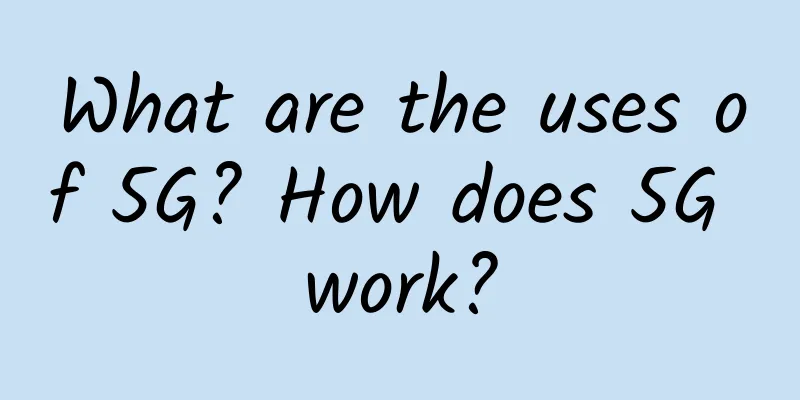Where is the domestic Wi-Fi 6 chip heading?

|
What was the past life like, what is the present life like, who is the WiFi 6 chip made for? WiFi chips have gone through 20 years, with both a promising future and a long time to look back. After 6 generations, from the first generation 802.11b to the future WiFi7 802.11be. For domestic WiFi chip companies, WiFi 6 chips are in the process of research and development. In terms of quantity, there are more than 50 domestic WiFi 6 chip companies. The market is optimistic, capital is hot, and the massive market of the Internet of Things seems to accommodate more WiFi chip companies. What is the truth? Let’s see where domestic WiFi 6 chips are heading. The past and present of WiFi 6 chipsBefore introducing the domestic WiFi 6 chip, let us first understand the origin of WiFi technology. WiFi wireless network technology was invented by CSIRO, an Australian government research institute, in the 1990s and successfully applied for a wireless network technology patent in the United States in 1996. The patent inventor was a research team led by Dr John O'Sullivan, a graduate of the University of Sydney's Faculty of Engineering. In fact, as early as 1990, a team began to develop the wireless communication protocol 802.11 standard, which was three years earlier than the work of the research institution CSIRO. However, the final result was that the research institution CSIRO applied for a patent. IEEE once asked the Australian government to give up its wireless network patents and let the world use Wi-Fi technology for free, but was rejected. The Australian government then won the lawsuit in the United States or settled out of court, collecting patent royalties from Apple, Intel, Lenovo, Dell, AT&T, Sony, Toshiba, Microsoft, Acer, Asus and other companies. By 2010, there were 3 billion electronic devices worldwide using WiFi wireless network technology, and by the end of 2013, when the WiFi wireless network patent of research organization CSIRO expired, the number of electronic devices using WiFi wireless technology increased to more than 5 billion. WiFi wireless network is hailed as the most important technological invention in Australia's history. Its inventor, Dr John O'Sullivan, is known as the "Father of Wi-Fi". He has won Australia's highest national science award and numerous accolades from around the world, including the European Inventor Award 2012 from the European Patent Office (EPO), an EU institution. According to the WiFi white paper released by Huawei, you can see the entire development process of WiFi technology. In 1997, IEEE developed the first wireless LAN communication standard 802.11, allowing wireless data transmission between devices at a speed of 2Mbps per second. In 1999, IEEE released the 802.11b standard, which has a transmission rate of 11Mbps and operates in the 2.4GHz frequency band. In the same year, IEEE released the 802.11a standard, which operates in the 5GHz frequency band and has a data transmission rate of 54Mbps. In 2000, the first generation of WiFi chip products came on the market, with a maximum data rate of 11Mbps and operating in the 2.4GHz frequency band. In 2003, WiFi chip products with faster speed and wider coverage were launched, forming the 802.11g standard with a data transmission speed of 54Mbps. In 2009, the 802.11n protocol standard was introduced, which introduced "Multiple Input Multiple Output" data (MIMO), using multiple antennas to enhance transmission and reception communications, with a maximum connection rate of 600 Mbit/s. The 802.11n standard WiFi chip has been used to this day, and its operating frequency band is 2.4GHz. In 2014, IEEE released 802.11ac, which has a speed of up to 3.5 Gbps but only supports the 5GHz frequency band. In 2019, 802.11ax was proposed by the WiFi Alliance, a wireless network standard, and supports both 2.4GHz and 5.8GHz. IEEE also named 802.11ax WiFi 6, and named the previous two generations of technology 802.11n and 802.11ac WiFi 4 and WiFi 5 respectively. After that, WiFi 6 was preceded by new names WiFi 5 and WiFi 4, but without WiFi 3/WiFi 2/WiFi 1; and WiFi 6E and WiFi 7 were added after it. WiFi 6 has a speed of up to 9.6 Gbps, which is nearly 3 times faster than WiFi 5's 3.5 Gbps. WiFi 6 not only has all the advanced MIMO features of WiFi 5, but the effects of OFDMA and MU-MIMO can be superimposed under WiFi 6, and the two present a complementary relationship. OFDMA is suitable for the parallel transmission of small data packets to improve channel utilization and transmission efficiency, while MU-MIMO is suitable for the parallel transmission of large data packets, which increases the effective bandwidth of a single user and also reduces latency. Higher-order modulation technology (1024-QAM), space division multiplexing technology (SR) & BSS Coloring coloring mechanism, and extended coverage (ER) enable WiFi 6 to better connect more devices and increase the speed of each device by at least 4 times. In 2020, the WiFi Alliance announced an extended version of WiFi 6, WiFi 6E (E stands for Extended). In addition to the original 2.4GHz and 5GHz operating bands, the 6GHz band (5925-7125 MHz, a total of 1.2 GHz bandwidth) was added. The new 6 GHz band is 1.2 GHz wide and can accommodate 7 160MHz bands or 14 80MHz bands. The Federal Communications Commission of the United States allocated the 1200 MHz unlicensed band of 6GHz to WiFi 6, and the European Union allocated the 400MHz band of 6GHz to WiFi 6. In 2021, WiFi 7, or the 802.11be protocol, was announced. Chip companies such as Qualcomm, Broadcom, and MediaTek are actively developing WiFi 7 chips. Compared with the maximum 8 data streams of WiFi 6, WiFi 7 will support 16 data streams and CMU-MIMO technology. Among them, C stands for Coordinated, which means that the 16 data streams may not be provided by one access point, but by multiple access points at the same time. Secondly, WiFi 7 will continue to support the 6GHz band, and three bands can be connected and work at the same time, expanding the width of a single channel from 160MHz of WiFi 6 to 320MHz. WiFi 7 also upgrades the signal modulation method to 4096QAM to have a larger data capacity. Therefore, the final speed of WiFi 7 can reach 30Gbps, which is three times the current fastest Wi-Fi 6 speed of 9.6Gbps. Where is the domestic WiFi 6 chip heading?The smartphone field is an important entry point for major chip manufacturers to enter the WiFi 6 market. According to the latest report from market research firm Strategy Analytics, by 2021, the smartphone WiFi chip market size will reach US$4.3 billion, and Qualcomm, Broadcom and MediaTek will occupy the top three positions in the market. Currently, mobile phone SoC processors that support WiFi 6 include Qualcomm's Snapdragon 888 and Snapdragon 865, Huawei HiSilicon's Kirin 9000/9000E, Kirin 900, Kirin 985, Apple's A14, MediaTek's Dimensity 1000+, and Broadcom's WiFi 6 chip BCM4375 module. However, domestic WiFi 6 chips cannot enter the smartphone market. Only Broadcom's four-in-one module stands out due to its excellent performance indicators. Otherwise, they are all integrated into the SOC processor. For the current domestic WiFi 6 chip manufacturers, where is the market that truly belongs to them? This is a problem that needs to be considered and solved. In addition to the smartphone market, where should domestic WiFi 6 chips go? Let's analyze and discuss it together. WiFi 4 Chip MarketWiFi chips are widely used in smart homes and smart monitoring, such as white appliance market (refrigerators, air conditioners, etc.), module market, lighting market, smart speaker monitoring, doorbells, cat eyes, etc. Among them, network cameras, smart sockets, WiFi smart lights, etc. have a large market scale and are currently the mainstream smart home products. NEST, Xiaomi, Tuya Smart, Haier, Gree, Midea and others have launched a series of smart home products. Overseas giant NEST has launched smart cameras, Hello smart video doorbells, NEST Yale locks, Thermostat thermostats and other products in the smart home field. These applications can meet the needs of WiFi 4 chips. WiFi 4 only supports 802.11n 2.4GHz frequency band. Do I need to upgrade to WiFi 6 chips? From the perspective of existing market applications, WiFi 6 chips are not needed, just like whether our mobile phones are 5G or 4G, it is the same for current consumers. If 5G is priced similarly to 4G, more people will choose 5G. Similarly, if WiFi 6 chips are priced like WiFi 4 chips, there will be a market. This is indeed the case. Currently, the most shipped chips on the market are still WiFi 4 chips. In order to seize the WiFi 4 chip market, domestic WiFi 6 chip companies are launching 2.4GHz WiFi 6 single-frequency chips to replace WiFi 4 chips at the same price. There is not much difficulty in technical implementation. The underlying protocol/communication protocol and algorithm are relatively easy. The RF front end (PA+LNA+SW) does not need to meet the 802.11ax standard, but only needs to meet the 802.11n standard. WiFi 5 Chip MarketIn order to meet the needs of video transmission, WiFi 5 chips were born. The WiFi 5 chip market is mainly in the smartphone, set-top box, module, drone and model aircraft, game console, computer, etc. According to data from the China Research Institute of Industry, the WiFi chip market size was 16.8 billion yuan in 2019, and the market size rose to 18.02 billion yuan in 2020, and is expected to reach 21.08 billion yuan in 2021. It is expected that by 2025, the Chinese WiFi chip market size will exceed 30 billion yuan, reaching 33.51 billion yuan, and the average annual compound growth rate of the market size from 2021 to 2025 will reach 12.2%. From the perspective of shipments, according to Gartner data, a total of 4.4 billion WiFi chips were shipped worldwide in 2020, and it is expected to reach about 4.9 billion in 2022. On December 31, 2021, market analysis agency DIGITIMES Research announced the shipment of smartphones in 2021. The annual shipment was about 1.32 billion units, an increase of only 6.1% year-on-year. Smartphones are the largest market for WiFi chips, accounting for about 30% in terms of shipment volume. Since mobile phones basically use WiFi5 or WiFi6 chips, sales are estimated to account for more than 60%. Outside of smartphones, the number of WiFi 5 chips only accounts for about 20%, most of which come from the WiFi 5 router market; nearly 80% of shipments come from WiFi 4 chips. Eventually, 20% of WiFi 5 chips will be replaced by WiFi 6 chips. WiFi 6 Chip MarketIn the past two years, the performance requirements of WiFi chips in IoT fields such as video transmission, video surveillance, and smart cities have continued to increase. WiFi 6 technology is highly applicable to new high-speed application scenarios such as VR/AR and ultra-high-definition video. In the future, the number of WiFi 6 chips for such applications will continue to increase. A report pointed out that WiFi 6 and WiFi 6E have driven the smartphone Wi-Fi chip market. The rapid adoption of these technologies has provided growth opportunities for WiFi chip manufacturers, driving the development of WiFi6/WiFi6E routers and the Internet of Things, and ushering in the spring for domestic router WiFi6 chips. From the perspective of the router market, the domestic WiFi 6 router chip market size was about 530 million yuan in 2019, and it is expected to exceed 10 billion yuan in 2023. As the leader of domestic router WiFi 6 chips, Sichang Communication will launch the first domestic WiFi 6 router chip in 2022. This previously untapped track has also attracted new startups, and their strength should not be underestimated. In the mobile WiFi 6 market, Broadcom is the only supplier other than baseband chip manufacturers. Broadcom cooperates with Apple, and iPhone 13 uses Broadcom products. In addition, Broadcom's BCM4375 products have been used in Samsung S20 series mobile phones. Broadcom has always maintained a leading position in the field of high-end WiFi chips. As early as 2020, Broadcom released the world's first WiFi 6E chip BCM4389 for smartphone mobile platforms. It uses a 16nm process and has a data transmission rate of 2.4Gbps. In this market, domestic WiFi 6 chip manufacturers can only watch in the short term. In the fiercely competitive WiFi market, domestic chip manufacturers are looking for new market segments to enter. In addition to international giants such as Qualcomm, Broadcom, and MediaTek, domestic WiFi chip manufacturers such as Espressif, Broadcom Integrated, Aoxiang Technology, and Boliu are also stepping up their layout in the WiFi 6 market. Espressif and Broadcom Integrated have launched IoT chips that support WiFi 6. Panqi Micro uses its advantage of being the first in the drone field to accelerate the development of WiFi 6 chips. Zhuhai Taixin develops WiFi chips based on the low-power, long-distance Wi-Fi HaLow™ new standard launched by the Wi-Fi Alliance and IEEE, and actively enters the WiFi 6 chip market with its market advantages. WiFi 6 goes to MCU, MCU goes to WiFi 6Recently, domestic MCU manufacturers have been approaching Sanwuwei, hoping to work together on WiFi RF front-end chips. Sanwuwei has advantages in both WiFi FEM performance and cost. Espressif has successfully moved from WiFi to MCU, but domestic MCUs are moving towards WiFi 6. Ganyao Electronics, a domestic MCU manufacturer, is one of them. The G32L473xx series MCU developed by Ganyao Electronics integrates the WiFi protocol stack and AFE front-end transceiver, and the WiFi RF front-end is externally equipped with Sanwuwei WiFi FEM.
In 2020, domestic MCU company SinoWen Electronics shipped more than 600 million units, and GigaDevice shipped nearly 200 million units. Although Espressif Technology shipped only 134 million units, it accounted for 30% of the IoT WiFi MCU market share (by sales volume), ranking first in the world. Espressif Technology's net profit attributable to shareholders of listed companies in 2020 was approximately 104 million yuan, and its operating income was approximately 831 million yuan. In terms of MCU business revenue, SinoWen Electronics is ahead of GigaDevice and Espressif Technology. In 2020, SinoWen Electronics' MCU operating income reached 950 million yuan. In recent years, the Internet of Things technology has developed vigorously, and new items such as smart speakers, smart home appliances (smart refrigerators, washing machines), sweeping robots, WiFi connections, industrial equipment interfaces, etc. have emerged in an endless stream. The WiFi MCU chip field is the key component for realizing the Internet of Things. In September 2021, GigaDevice announced that it will launch WiFi MCU products, with the goal of improving solutions around the MCU ecosystem, built around the company's core, general MCU business and customer needs. This means that GigaDevice has officially entered the WiFi 6 MCU field. From the perspective of market layout, GigaDevice's MCU products are mainly used in automotive electronics, industry and other fields; SinoWing's products are mainly used in small home appliances; and Espressif's products are mainly used in the Internet of Things. With the rise of Internet of Vehicles and Industrial Internet of Things, GigaDevice's WiFi 6 MCU will have an advantage in this field. In recent years, the development of smart home appliances has also been very rapid. As the MCU leader in the field of small home appliances, SinoWing's strategic layout is very focused and it has its own profound understanding of the ecosystem. By acquiring Lanzhi Technology's WiFi business, horizontal integration has driven synergy effects and joined the WiFi 6 MCU track. At present, Espressif Technology is better at developing WiFi 6 MCU products, and is in a leading position in terms of R&D technology and process. Short-distance communication is the main connection method for the Internet of Things in the future, and WiFi is the main application technology for short-distance communication. Cost-effective WiFi MCU will be the trend, and the integration process of WiFi 6 and MCU will make WiFi 6 technology more difficult. From the perspective of domestic and foreign companies, the acquisition of WiFi business can strengthen their layout in the Internet of Things, smart home, smart city, etc. From the perspective of the entire industry, it has played a certain role in forming the current market structure of WiFi 6 MCU, enabling WiFi 6 MCU to accelerate its entry into new IoT application fields in the industrial and consumer markets.
ConclusionThe world changes with the tides coming and going. Technology develops and everything is connected. 5G and WiFi 6, one changes the world, the other changes life. In the entrepreneurial tide of domestic WiFi 6 chips, how many years have passed, how much time has gone and how many chip companies have joined in. If domestic WiFi 6 chips can grow up under this wave of capital and seize the opportunities given by the times, they will reap a lot. Finally, I would like to share with you a classic story: During the gold rush in the western United States in the 19th century, speculators from all over the world flocked to California, Oregon and other places to pan for gold, hoping to get rich overnight. There were so many people panning for gold, and the competition was fierce. In the end, only a few got rich overnight, while most people returned empty-handed, and some even lost everything. However, some people came to the West to sell shovels. When the tide receded, the people who "sold shovels" made the most money. In the WiFi 6 chip startup boom, who will make the most money in the end? Perhaps CEVA. |
<<: Won the award again! Ruijie Networks won the title of "2021 ICT Industry Influential Enterprise"
>>: Does Overlay require RDMA and Segment Routing?
Recommend
edgeNAT Double Holiday Promotion: VPS special price starting from 199 yuan per year, 30% off for regular monthly packages and 40% off for annual packages
edgeNAT has just released a promotional event dur...
Forty-five kinds of traditional knowledge about optical fiber and optical cable
1. Briefly describe the composition of optical fi...
After talking so much about 5G, the most critical technology is here
When it comes to antennas, everyone must be famil...
LiCloud National Day Promotion: Hong Kong dedicated server first month from $19.99, Hong Kong high bandwidth VPS annual payment from $17
LiCloud.io has launched this year's National ...
ChatGPT and 5G messaging: the perfect combination of new artificial intelligence and new communications
At present, the hottest topic is none other than ...
Sharktech: High-defense servers start at $69 per month, with data centers in Los Angeles, Denver, Chicago, etc.
Sharktech, also known as Shark Data Center or SK ...
Let’s talk about what CDN is. Do you know these characteristics?
Preface When we browse the web, watch videos, and...
SpartanHost: 1TB large hard disk VPS starts at $6/month, 10Gbps large bandwidth high-security VPS starts at 20% off $4/month
SpartanHost, also known as Sparta, is a foreign h...
Accelerate the release of new infrastructure value with data as the core
[[341973]] Yu Yingtao, Co-President of Tsinghua U...
Say goodbye to manual operations! Use Ansible user module to efficiently manage Linux accounts
In an enterprise operation and maintenance enviro...
Cisco pledges to be carbon neutral by 2040
In response to calls to limit global warming to 1...
Deutsche Telekom recently successfully tested 5G independent networking
Deutsche Telekom (DT) said it has completed its f...
Chinese Academy of Engineering Academician: 5G will consume 2.1% of national electricity consumption in 2026
On the afternoon of September 1st, at the "5...
5G era: Will WiFi disappear from people’s lives?
WiFi has gradually penetrated into our daily live...









